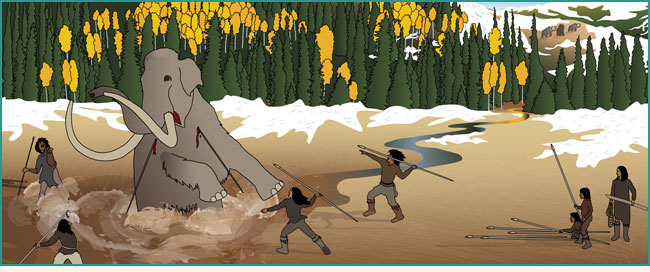
Archaeologists often refer to the era prior to 6000 BCE in North America as Paleo-Indian. This appears to have been a time when the people specialized in the hunting of big game. At this time, the Plateau area—roughly the area between the Rocky Mountains and the Cascade Mountains, had emerged from the effects of glacial ice.
Writing about the Southern Plateau in the Handbook of North American Indians, Kenneth Ames, Don Dumond, Jerry Galm, and Rick Minor report:
“People appear to have moved frequently; there is no evidence of dwellings or structures of any kind during this period, as there is also no evidence of food storage. Hunter-gatherers under these conditions can be expected to have quite low population densities.”
In looking at the earliest history of American Indians in what is now the state of Idaho, there are two major cautions: (1) Idaho is a totally arbitrary area defined by much later political concerns unrelated to American Indian history, and (2) the archaeological record is far from complete. There are large temporal gaps in our understanding of this early time period. Briefly described below are some of the archaeological sites from this time period.
American Falls: about 28,000 BCE (Before Current Era), Indian people near the American Falls on the Snake River were killing bison. Note: this early date is controversial and not accepted by most archaeologists.
Wilson Butte Cave: by 13,000 BCE, Indian people began using the Wilson Butte Cave in southern Idaho as a shelter. They were using bifacially worked points and blades.
Intermountain Stemmed Point Tradition: by 11,500 BCE, a hunting camp was established by Indians using what archaeologists call the Intermountain Stemmed Point Tradition.
Hatwai: by about 10,900 BCE, Indian people were fishing with nets at the Hatwai site (10NP143).
Burial: about 10,600 BCE, a young woman (17-21 years of age) died near the Snake River in the south-central part of the state. She was buried with a large stemmed biface, an eyed needle, a badger baculum, and a bone artifact. She was 5’2” tall and had regularly faced hunger as she was growing up. Salmon had provided some of the protein (possibly 10%) in her diet. Her diet also included processed meat, such as pemmican.
Shoup Rockshelter: by 10,460 BCE, Indian people were occupying the Shoup Rockshelter near Salmon, Idaho.
Owl Cave: by 10,250 BCE, Indian people were occupying Owl Cave. By 8850 BCE, Indian people living at Owl Cave were butchering and eating mammoth.
By 6000, BCE, Indians were using Owl Cave as a site for the systematic killing of buffalo. According to archaeologist B. Robert Butler in the Handbook of North American Indians:
“Apparently, each of the Owl Cave kills resulted from a well-planned and coordinated undertaking in which herds of 30 or more Bison antiquus were induced or driven into the cave, dispatched with spear thrust into the body cavities, and then systematically butchered.”
Cooper’s Ferry Site: about 10,050 BCE, a group of hunting people left a cache of tools in a circular pit at one of their regular camp sites along the lower Salmon River Canyon. The site is located on a small alluvial terrace about ten meters above the confluence of Rock Creek and the lower Salmon River. The tools included stone points and scrapers. Some of the tools had been used and then reworked to renew their cutting surfaces. Caching of equipment for future use was relatively common among nomadic peoples. In an article in American Antiquity, Loren Davis, Alex Nyers, and Samuel Willis write:
“In this manner, equipment manufactured for tasks that are specific to a particular time and place are stored in a designed holding facility. Equipment caches might also play a role as insurance or backup systems, where additional stores of tools are placed at strategic locations in the landscape as a low-cost, embedded aspect of moving in a landscape.”
They also write:
“Overall, the creation and use of equipment caches is intended to help solve problems of logistical mobility and improve efficiency in resource exploitation.”
By 10,020 BCE, Indian people at the Cooper’s Ferry site were using a variety of stemmed points, including those which archaeologists classify as Lind Coulee, Windust, and Cascade.
By 9400 BCE, Indian people with a Western Stemmed Tradition technology occupied the Cooper’s Ferry Site. Many archaeologists feel that the people who used the Western Stemmed Tradition technology were different from those who used Clovis technology.
By 9000 BCE, Indians from the Cooper’s Ferry Site were hunting in the Beaverhead Mountains. They were using Lind Coulee type spear points. Roy Carlson, in the Indian Art Traditions of the Northwest Coast, writes:
“The Lind Coulee Tradition is characterized by large stemmed projectile points, chipped stone crescents, and large steep scrapers.”
Bison and Veratic Rockshelters: by 8390 BCE Indian people at the Bison Rockshelter and the Veratic Rockshelter were using stone points which are pressure-flaked and fluted.
We’eptes Pa’axat: by 8200 BCE, Indian people were occupying the We’eptes Pa’axat (Five Eagles) site near present-day Lenore, Idaho. The site was being used intermittently for hunting and processing deer and mountain sheep as well as for manufacturing stone tools.
Redfish Overhang: by 8150 BCE, Indian people began to occupy the Redfish Overhang near Stanley, Idaho.
Note: the information in parenthesis following the name of the site is the Smithsonian Designation System. In this system of recording archaeological sites, the first number refers to the state; this is followed by letters which refer to the county; and then a number indicating its order in being recorded. Thus 5LP 10, means that the site is in Colorado (5th state when the states are listed alphabetically), La Plata County (LP), and was the 10th site recorded in La Plata county in the State Archaeologist’s office.
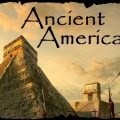
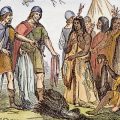
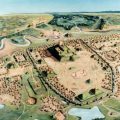
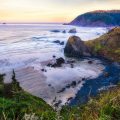
Leave a Reply